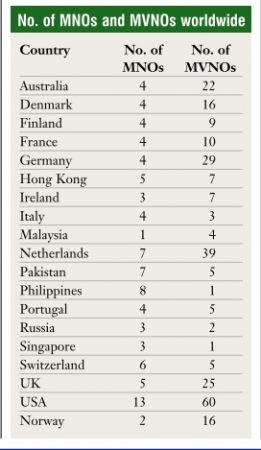MVNO Entry - TRAI consultation paper addresses key issues

-
The Telecom Regulatory Authority of India (TRAI) has released a consultation paper on the need and timing for introducing mobile virtual network operators (MVNOs). The paper also discusses the terms and conditions of the licence to be granted to such operators.
MVNOs typically operate through commercial arrangements with licensed mobile network operators (MNOs). They do not have their own spectrum. Hence, they share the spectrum of the parent MNO, buy bulk minutes of traffic and resell them to their own subscribers, usually using their own brand name. The main difference between a franchisee and an MVNO is that the latter adds value to the service and offers differentiated services to niche market segments.
So far, MVNOs have not been allowed to operate in India. The issue of MVNO entry came up during the consultation process on infrastructure sharing. The idea was to take the concept of infrastructure sharing a step further, as the MVNO would be sharing not just active/passive infrastructure but also the spectrum of the parent MNO. There was a consensus that the issue of MVNOs should be addressed separately.
According to TRAI, the introduction of MVNOs is a natural progression towards enhancing free market principles and making efficient use of existing telecommunication infrastructure. With various categories of mobile users emerging, it is becoming increasingly more difficult for large operators to service their diverse requirements effectively. On the other hand, niche operators, who often have better knowledge of the local market, can better address the needs of specific customer segments. In short, the framework of wholesale and retail becomes important.
The MVNO model has gained popularity in the past few years. There are currently over 300 MVNOs registered throughout the world. While some MVNOs have emerged from within the telecom industry, many others are complete "outsiders". Such entities attempt to leverage their popularity and brand appeal with certain segments of the population to crosssell mobile services.
MVNOs help widen and deepen the MNO's market. Their effort is to take mobile services beyond pure telecommunications and expand the MNO's market by reaching entirely new or previously unserved/underserved market segments or geographical areas. They also facilitate better network utilisation and realisation of economies of scale. The range of MVNOs is fairly wide, the simplest being an enhanced franchisee of the MNO to a full MVNO that functions just like the MNO, except that spectrum is not allotted to it.
In the Indian context, the regulatory and licensing issues for MVNOs need to be discussed keeping in mind the existing licensing provisions for MNOs. According to TRAI, in order to promote MVNOs in an enabling regime, the entry barrier should be such that they are viable.
TRAI's consultation paper highlights various issues relating to the introduction of MVNOs in India. These include:
Over and above these issues, the consultation paper also discusses possible business strategies of MVNOs, such as low-priced services, focusing on specific customer segments, offering differentiated value-added services and international clustering.
- Most Viewed
- Most Rated
- Most Shared
- Related Articles
- Manufacturing Hub: India emerges as a ke...
- TRAI performance indicator report for Se...
- Prashant Singhal, partner, telecom indus...
- 2G spectrum scam: continuing controversy
- An Eventful Year: Telecom highlights of ...
- Telecom Round Table: TRAI’s spectrum p...
- Manufacturing Hub: TRAI recommends indig...
- Linking Up: ITIL to merge with Ascend
- High Speed VAS - Killer applications w...
- Bharti Airtel seals deal with Zain - Zai...






